The Ageing Crisis: Challenges and Reforms in Correctional Facilities
VerifiedAdded on 2023/01/05
|7
|2610
|37
Essay
AI Summary
This essay delves into the significant challenges posed by the ageing crisis within correctional facilities, highlighting the financial, medical, and programmatic strains on healthcare systems. It examines the rising number of elderly inmates and their complex needs, often unmet by facilities designed for younger populations. The essay discusses the importance of geriatric care, the impact of social isolation, and the need for policy reforms, including compassionate release and alternative sentencing options. It explores the legal and ethical considerations surrounding the healthcare of older prisoners, advocating for standards comparable to those in the community. Furthermore, the essay addresses the economic impacts of incarcerating older adults, emphasizing the need for data transparency and cost-effective solutions. The author also discusses the importance of geriatric health care models in correctional settings and highlights the psychological challenges faced by elderly inmates, such as mental health issues and social isolation, and suggests strategies for the reform of the correctional system to meet the needs of older inmates, including health care and mental health support, and ultimately, to improve the quality of life and outcomes for this vulnerable population.
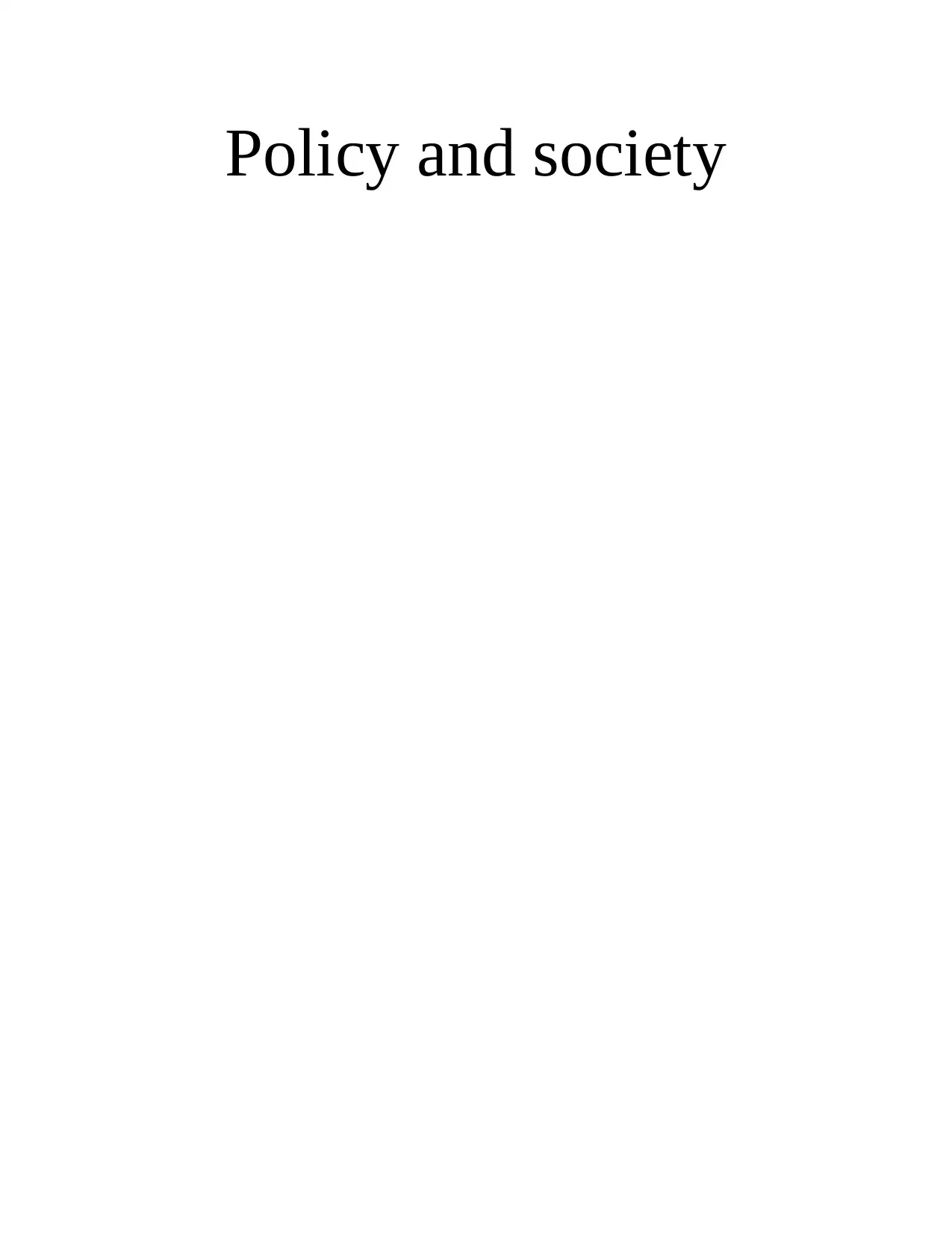
Policy and society
Paraphrase This Document
Need a fresh take? Get an instant paraphrase of this document with our AI Paraphraser
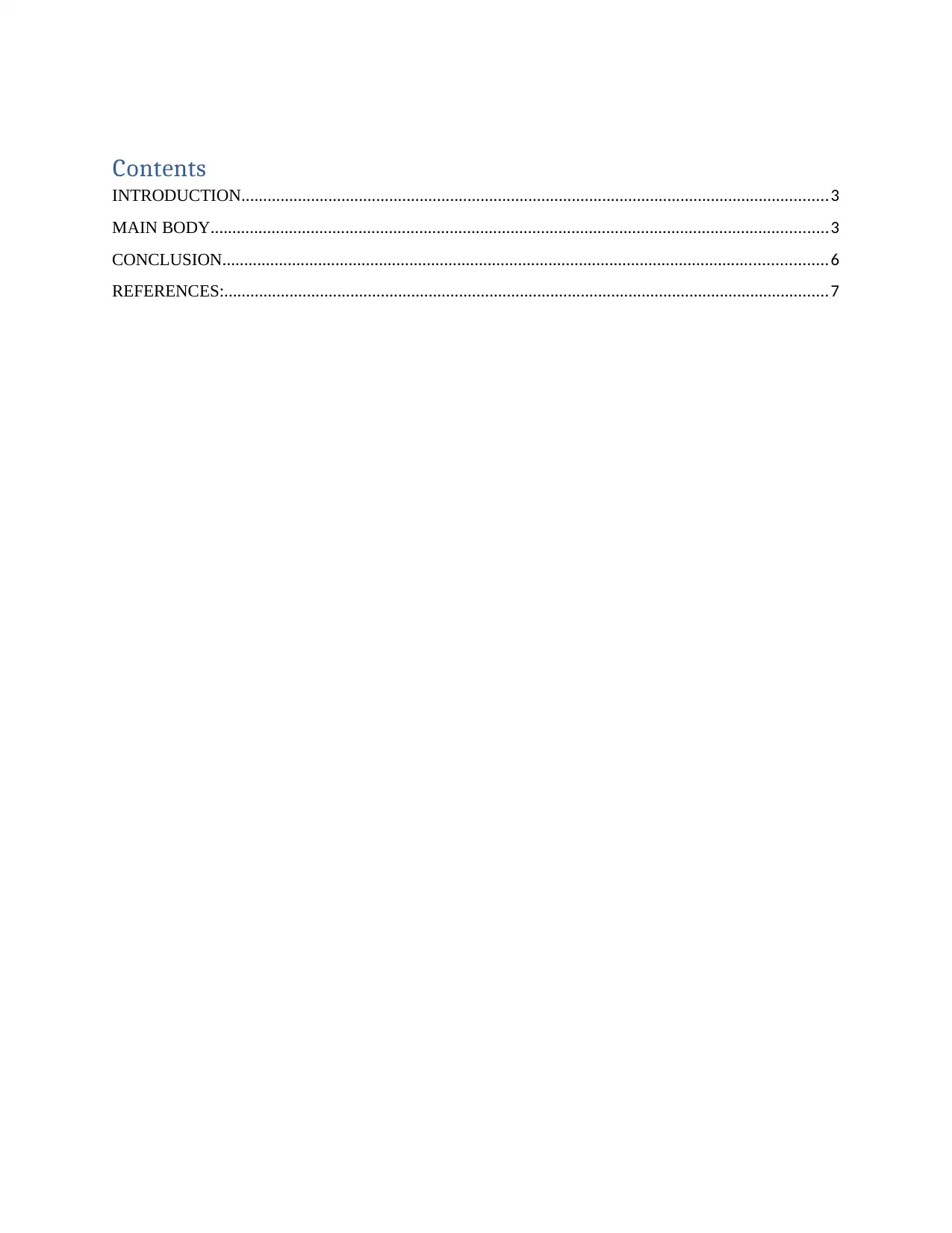
Contents
INTRODUCTION.......................................................................................................................................3
MAIN BODY..............................................................................................................................................3
CONCLUSION...........................................................................................................................................6
REFERENCES:...........................................................................................................................................7
INTRODUCTION.......................................................................................................................................3
MAIN BODY..............................................................................................................................................3
CONCLUSION...........................................................................................................................................6
REFERENCES:...........................................................................................................................................7
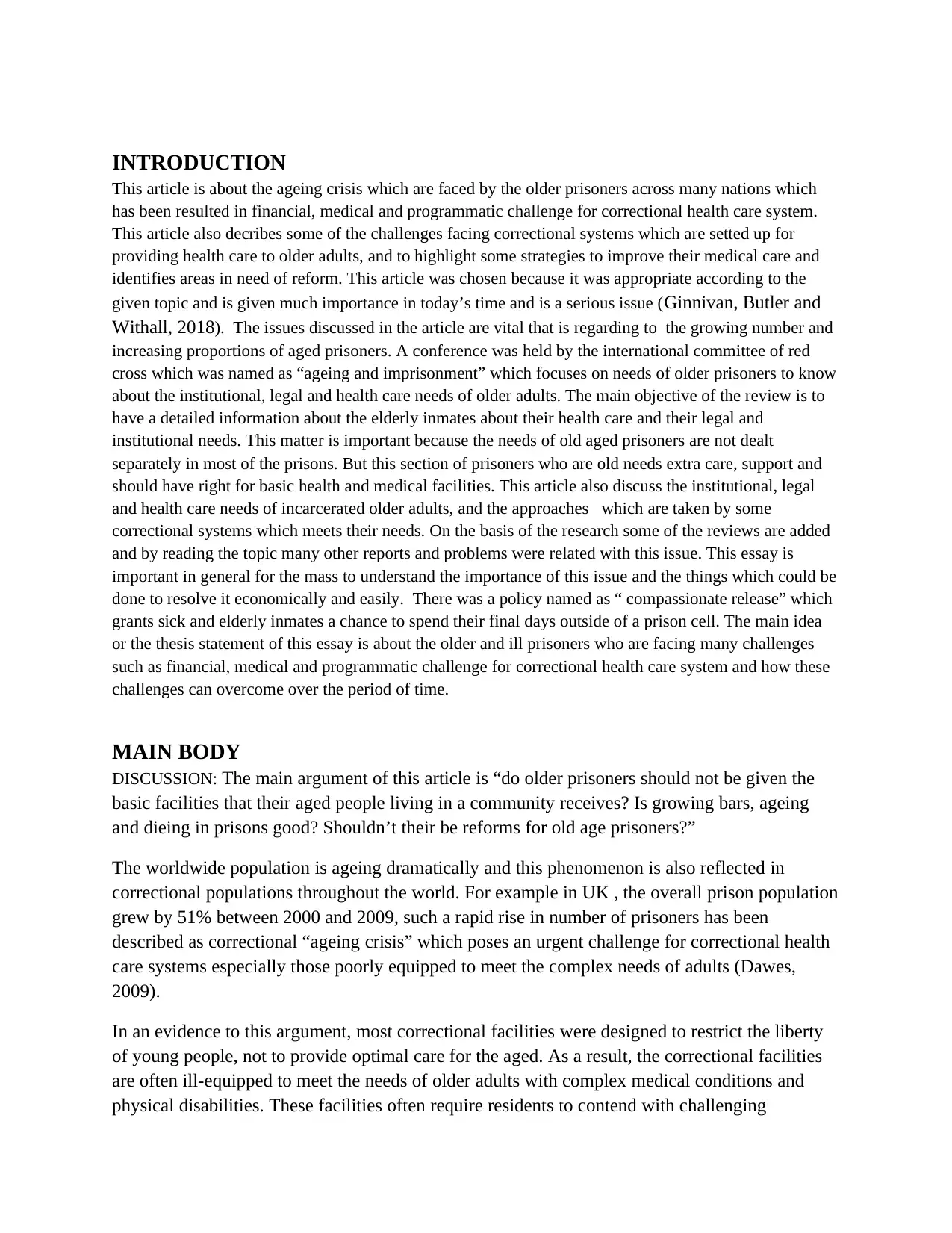
INTRODUCTION
This article is about the ageing crisis which are faced by the older prisoners across many nations which
has been resulted in financial, medical and programmatic challenge for correctional health care system.
This article also decribes some of the challenges facing correctional systems which are setted up for
providing health care to older adults, and to highlight some strategies to improve their medical care and
identifies areas in need of reform. This article was chosen because it was appropriate according to the
given topic and is given much importance in today’s time and is a serious issue (Ginnivan, Butler and
Withall, 2018). The issues discussed in the article are vital that is regarding to the growing number and
increasing proportions of aged prisoners. A conference was held by the international committee of red
cross which was named as “ageing and imprisonment” which focuses on needs of older prisoners to know
about the institutional, legal and health care needs of older adults. The main objective of the review is to
have a detailed information about the elderly inmates about their health care and their legal and
institutional needs. This matter is important because the needs of old aged prisoners are not dealt
separately in most of the prisons. But this section of prisoners who are old needs extra care, support and
should have right for basic health and medical facilities. This article also discuss the institutional, legal
and health care needs of incarcerated older adults, and the approaches which are taken by some
correctional systems which meets their needs. On the basis of the research some of the reviews are added
and by reading the topic many other reports and problems were related with this issue. This essay is
important in general for the mass to understand the importance of this issue and the things which could be
done to resolve it economically and easily. There was a policy named as “ compassionate release” which
grants sick and elderly inmates a chance to spend their final days outside of a prison cell. The main idea
or the thesis statement of this essay is about the older and ill prisoners who are facing many challenges
such as financial, medical and programmatic challenge for correctional health care system and how these
challenges can overcome over the period of time.
MAIN BODY
DISCUSSION: The main argument of this article is “do older prisoners should not be given the
basic facilities that their aged people living in a community receives? Is growing bars, ageing
and dieing in prisons good? Shouldn’t their be reforms for old age prisoners?”
The worldwide population is ageing dramatically and this phenomenon is also reflected in
correctional populations throughout the world. For example in UK , the overall prison population
grew by 51% between 2000 and 2009, such a rapid rise in number of prisoners has been
described as correctional “ageing crisis” which poses an urgent challenge for correctional health
care systems especially those poorly equipped to meet the complex needs of adults (Dawes,
2009).
In an evidence to this argument, most correctional facilities were designed to restrict the liberty
of young people, not to provide optimal care for the aged. As a result, the correctional facilities
are often ill-equipped to meet the needs of older adults with complex medical conditions and
physical disabilities. These facilities often require residents to contend with challenging
This article is about the ageing crisis which are faced by the older prisoners across many nations which
has been resulted in financial, medical and programmatic challenge for correctional health care system.
This article also decribes some of the challenges facing correctional systems which are setted up for
providing health care to older adults, and to highlight some strategies to improve their medical care and
identifies areas in need of reform. This article was chosen because it was appropriate according to the
given topic and is given much importance in today’s time and is a serious issue (Ginnivan, Butler and
Withall, 2018). The issues discussed in the article are vital that is regarding to the growing number and
increasing proportions of aged prisoners. A conference was held by the international committee of red
cross which was named as “ageing and imprisonment” which focuses on needs of older prisoners to know
about the institutional, legal and health care needs of older adults. The main objective of the review is to
have a detailed information about the elderly inmates about their health care and their legal and
institutional needs. This matter is important because the needs of old aged prisoners are not dealt
separately in most of the prisons. But this section of prisoners who are old needs extra care, support and
should have right for basic health and medical facilities. This article also discuss the institutional, legal
and health care needs of incarcerated older adults, and the approaches which are taken by some
correctional systems which meets their needs. On the basis of the research some of the reviews are added
and by reading the topic many other reports and problems were related with this issue. This essay is
important in general for the mass to understand the importance of this issue and the things which could be
done to resolve it economically and easily. There was a policy named as “ compassionate release” which
grants sick and elderly inmates a chance to spend their final days outside of a prison cell. The main idea
or the thesis statement of this essay is about the older and ill prisoners who are facing many challenges
such as financial, medical and programmatic challenge for correctional health care system and how these
challenges can overcome over the period of time.
MAIN BODY
DISCUSSION: The main argument of this article is “do older prisoners should not be given the
basic facilities that their aged people living in a community receives? Is growing bars, ageing
and dieing in prisons good? Shouldn’t their be reforms for old age prisoners?”
The worldwide population is ageing dramatically and this phenomenon is also reflected in
correctional populations throughout the world. For example in UK , the overall prison population
grew by 51% between 2000 and 2009, such a rapid rise in number of prisoners has been
described as correctional “ageing crisis” which poses an urgent challenge for correctional health
care systems especially those poorly equipped to meet the complex needs of adults (Dawes,
2009).
In an evidence to this argument, most correctional facilities were designed to restrict the liberty
of young people, not to provide optimal care for the aged. As a result, the correctional facilities
are often ill-equipped to meet the needs of older adults with complex medical conditions and
physical disabilities. These facilities often require residents to contend with challenging
⊘ This is a preview!⊘
Do you want full access?
Subscribe today to unlock all pages.

Trusted by 1+ million students worldwide
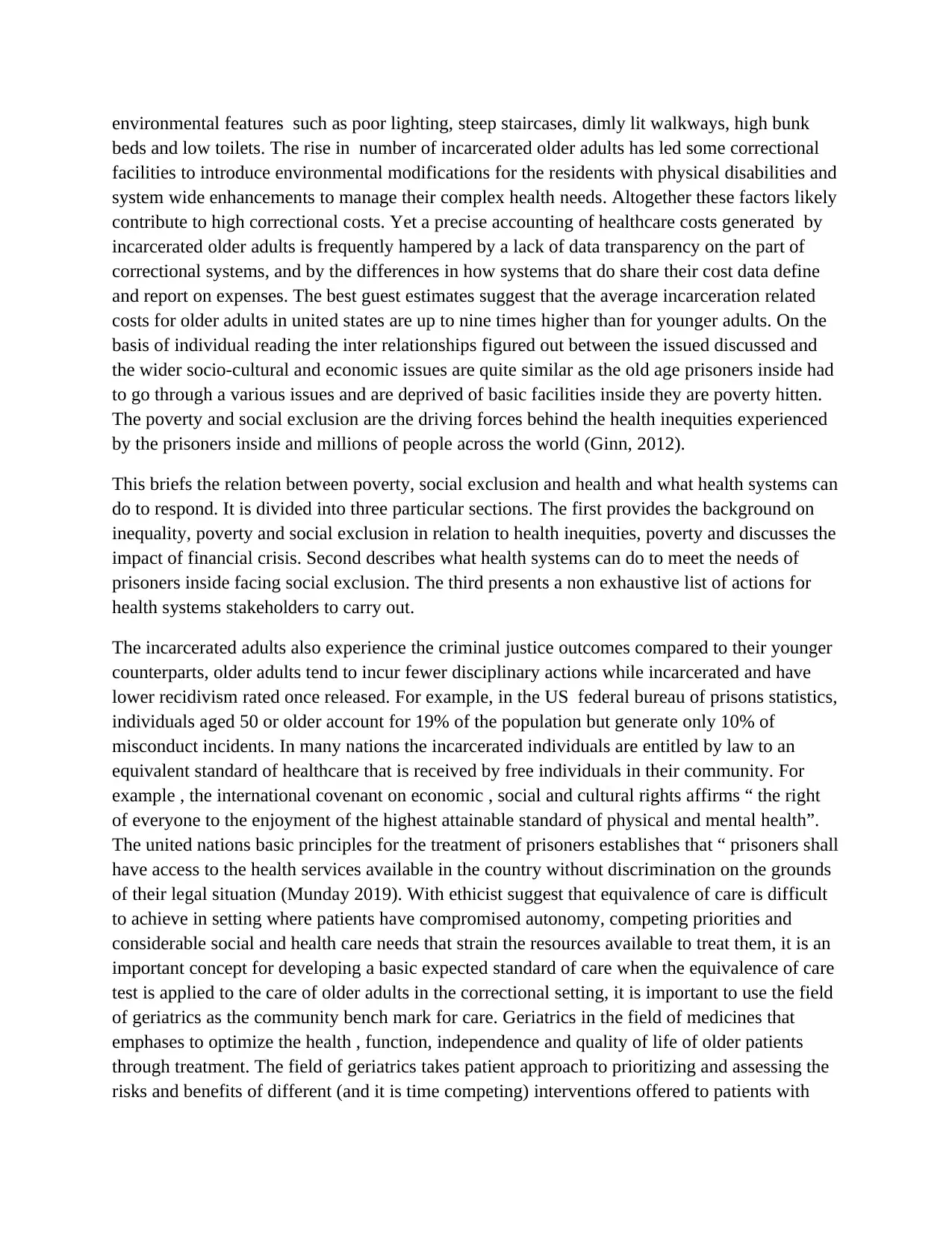
environmental features such as poor lighting, steep staircases, dimly lit walkways, high bunk
beds and low toilets. The rise in number of incarcerated older adults has led some correctional
facilities to introduce environmental modifications for the residents with physical disabilities and
system wide enhancements to manage their complex health needs. Altogether these factors likely
contribute to high correctional costs. Yet a precise accounting of healthcare costs generated by
incarcerated older adults is frequently hampered by a lack of data transparency on the part of
correctional systems, and by the differences in how systems that do share their cost data define
and report on expenses. The best guest estimates suggest that the average incarceration related
costs for older adults in united states are up to nine times higher than for younger adults. On the
basis of individual reading the inter relationships figured out between the issued discussed and
the wider socio-cultural and economic issues are quite similar as the old age prisoners inside had
to go through a various issues and are deprived of basic facilities inside they are poverty hitten.
The poverty and social exclusion are the driving forces behind the health inequities experienced
by the prisoners inside and millions of people across the world (Ginn, 2012).
This briefs the relation between poverty, social exclusion and health and what health systems can
do to respond. It is divided into three particular sections. The first provides the background on
inequality, poverty and social exclusion in relation to health inequities, poverty and discusses the
impact of financial crisis. Second describes what health systems can do to meet the needs of
prisoners inside facing social exclusion. The third presents a non exhaustive list of actions for
health systems stakeholders to carry out.
The incarcerated adults also experience the criminal justice outcomes compared to their younger
counterparts, older adults tend to incur fewer disciplinary actions while incarcerated and have
lower recidivism rated once released. For example, in the US federal bureau of prisons statistics,
individuals aged 50 or older account for 19% of the population but generate only 10% of
misconduct incidents. In many nations the incarcerated individuals are entitled by law to an
equivalent standard of healthcare that is received by free individuals in their community. For
example , the international covenant on economic , social and cultural rights affirms “ the right
of everyone to the enjoyment of the highest attainable standard of physical and mental health”.
The united nations basic principles for the treatment of prisoners establishes that “ prisoners shall
have access to the health services available in the country without discrimination on the grounds
of their legal situation (Munday 2019). With ethicist suggest that equivalence of care is difficult
to achieve in setting where patients have compromised autonomy, competing priorities and
considerable social and health care needs that strain the resources available to treat them, it is an
important concept for developing a basic expected standard of care when the equivalence of care
test is applied to the care of older adults in the correctional setting, it is important to use the field
of geriatrics as the community bench mark for care. Geriatrics in the field of medicines that
emphases to optimize the health , function, independence and quality of life of older patients
through treatment. The field of geriatrics takes patient approach to prioritizing and assessing the
risks and benefits of different (and it is time competing) interventions offered to patients with
beds and low toilets. The rise in number of incarcerated older adults has led some correctional
facilities to introduce environmental modifications for the residents with physical disabilities and
system wide enhancements to manage their complex health needs. Altogether these factors likely
contribute to high correctional costs. Yet a precise accounting of healthcare costs generated by
incarcerated older adults is frequently hampered by a lack of data transparency on the part of
correctional systems, and by the differences in how systems that do share their cost data define
and report on expenses. The best guest estimates suggest that the average incarceration related
costs for older adults in united states are up to nine times higher than for younger adults. On the
basis of individual reading the inter relationships figured out between the issued discussed and
the wider socio-cultural and economic issues are quite similar as the old age prisoners inside had
to go through a various issues and are deprived of basic facilities inside they are poverty hitten.
The poverty and social exclusion are the driving forces behind the health inequities experienced
by the prisoners inside and millions of people across the world (Ginn, 2012).
This briefs the relation between poverty, social exclusion and health and what health systems can
do to respond. It is divided into three particular sections. The first provides the background on
inequality, poverty and social exclusion in relation to health inequities, poverty and discusses the
impact of financial crisis. Second describes what health systems can do to meet the needs of
prisoners inside facing social exclusion. The third presents a non exhaustive list of actions for
health systems stakeholders to carry out.
The incarcerated adults also experience the criminal justice outcomes compared to their younger
counterparts, older adults tend to incur fewer disciplinary actions while incarcerated and have
lower recidivism rated once released. For example, in the US federal bureau of prisons statistics,
individuals aged 50 or older account for 19% of the population but generate only 10% of
misconduct incidents. In many nations the incarcerated individuals are entitled by law to an
equivalent standard of healthcare that is received by free individuals in their community. For
example , the international covenant on economic , social and cultural rights affirms “ the right
of everyone to the enjoyment of the highest attainable standard of physical and mental health”.
The united nations basic principles for the treatment of prisoners establishes that “ prisoners shall
have access to the health services available in the country without discrimination on the grounds
of their legal situation (Munday 2019). With ethicist suggest that equivalence of care is difficult
to achieve in setting where patients have compromised autonomy, competing priorities and
considerable social and health care needs that strain the resources available to treat them, it is an
important concept for developing a basic expected standard of care when the equivalence of care
test is applied to the care of older adults in the correctional setting, it is important to use the field
of geriatrics as the community bench mark for care. Geriatrics in the field of medicines that
emphases to optimize the health , function, independence and quality of life of older patients
through treatment. The field of geriatrics takes patient approach to prioritizing and assessing the
risks and benefits of different (and it is time competing) interventions offered to patients with
Paraphrase This Document
Need a fresh take? Get an instant paraphrase of this document with our AI Paraphraser
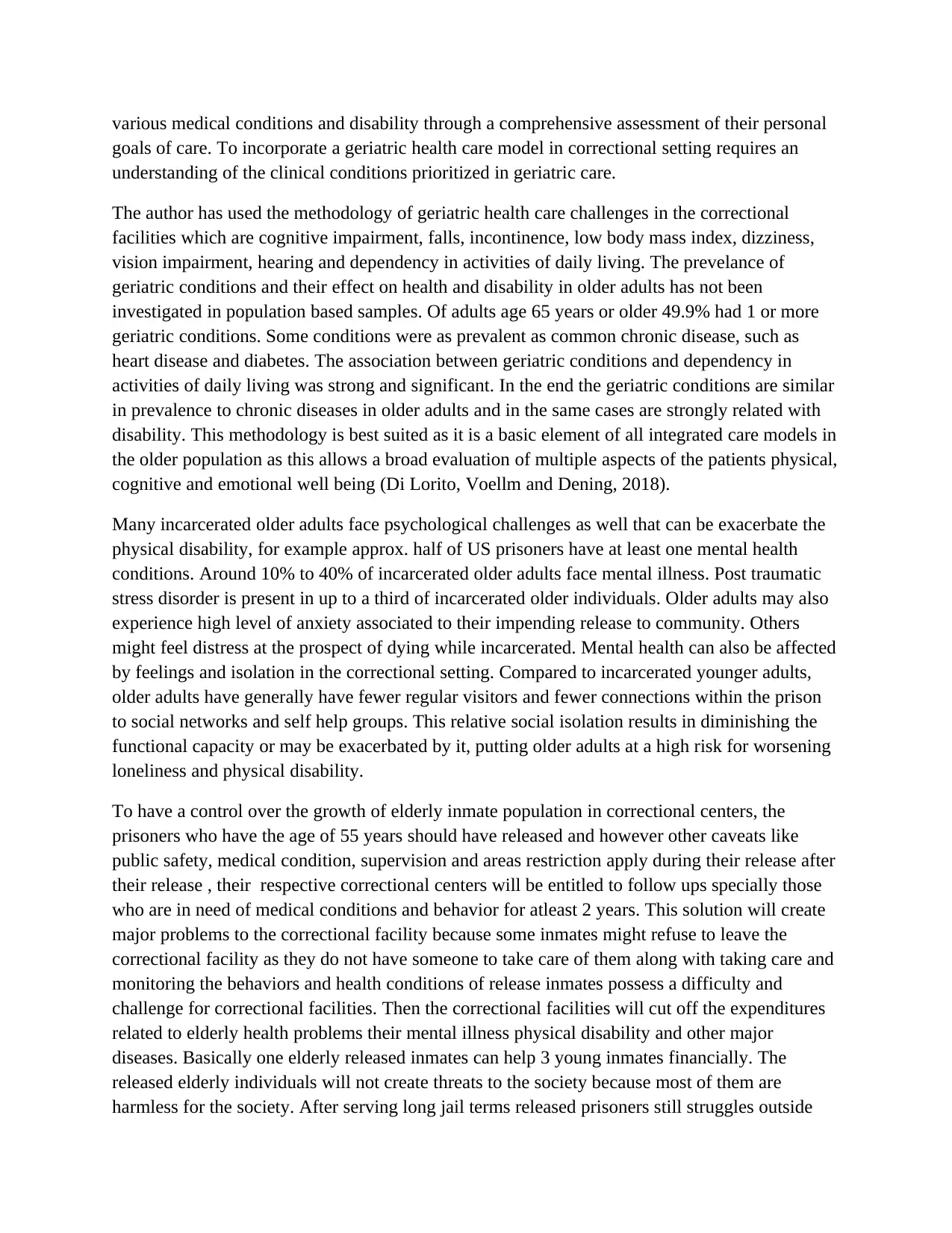
various medical conditions and disability through a comprehensive assessment of their personal
goals of care. To incorporate a geriatric health care model in correctional setting requires an
understanding of the clinical conditions prioritized in geriatric care.
The author has used the methodology of geriatric health care challenges in the correctional
facilities which are cognitive impairment, falls, incontinence, low body mass index, dizziness,
vision impairment, hearing and dependency in activities of daily living. The prevelance of
geriatric conditions and their effect on health and disability in older adults has not been
investigated in population based samples. Of adults age 65 years or older 49.9% had 1 or more
geriatric conditions. Some conditions were as prevalent as common chronic disease, such as
heart disease and diabetes. The association between geriatric conditions and dependency in
activities of daily living was strong and significant. In the end the geriatric conditions are similar
in prevalence to chronic diseases in older adults and in the same cases are strongly related with
disability. This methodology is best suited as it is a basic element of all integrated care models in
the older population as this allows a broad evaluation of multiple aspects of the patients physical,
cognitive and emotional well being (Di Lorito, Voellm and Dening, 2018).
Many incarcerated older adults face psychological challenges as well that can be exacerbate the
physical disability, for example approx. half of US prisoners have at least one mental health
conditions. Around 10% to 40% of incarcerated older adults face mental illness. Post traumatic
stress disorder is present in up to a third of incarcerated older individuals. Older adults may also
experience high level of anxiety associated to their impending release to community. Others
might feel distress at the prospect of dying while incarcerated. Mental health can also be affected
by feelings and isolation in the correctional setting. Compared to incarcerated younger adults,
older adults have generally have fewer regular visitors and fewer connections within the prison
to social networks and self help groups. This relative social isolation results in diminishing the
functional capacity or may be exacerbated by it, putting older adults at a high risk for worsening
loneliness and physical disability.
To have a control over the growth of elderly inmate population in correctional centers, the
prisoners who have the age of 55 years should have released and however other caveats like
public safety, medical condition, supervision and areas restriction apply during their release after
their release , their respective correctional centers will be entitled to follow ups specially those
who are in need of medical conditions and behavior for atleast 2 years. This solution will create
major problems to the correctional facility because some inmates might refuse to leave the
correctional facility as they do not have someone to take care of them along with taking care and
monitoring the behaviors and health conditions of release inmates possess a difficulty and
challenge for correctional facilities. Then the correctional facilities will cut off the expenditures
related to elderly health problems their mental illness physical disability and other major
diseases. Basically one elderly released inmates can help 3 young inmates financially. The
released elderly individuals will not create threats to the society because most of them are
harmless for the society. After serving long jail terms released prisoners still struggles outside
goals of care. To incorporate a geriatric health care model in correctional setting requires an
understanding of the clinical conditions prioritized in geriatric care.
The author has used the methodology of geriatric health care challenges in the correctional
facilities which are cognitive impairment, falls, incontinence, low body mass index, dizziness,
vision impairment, hearing and dependency in activities of daily living. The prevelance of
geriatric conditions and their effect on health and disability in older adults has not been
investigated in population based samples. Of adults age 65 years or older 49.9% had 1 or more
geriatric conditions. Some conditions were as prevalent as common chronic disease, such as
heart disease and diabetes. The association between geriatric conditions and dependency in
activities of daily living was strong and significant. In the end the geriatric conditions are similar
in prevalence to chronic diseases in older adults and in the same cases are strongly related with
disability. This methodology is best suited as it is a basic element of all integrated care models in
the older population as this allows a broad evaluation of multiple aspects of the patients physical,
cognitive and emotional well being (Di Lorito, Voellm and Dening, 2018).
Many incarcerated older adults face psychological challenges as well that can be exacerbate the
physical disability, for example approx. half of US prisoners have at least one mental health
conditions. Around 10% to 40% of incarcerated older adults face mental illness. Post traumatic
stress disorder is present in up to a third of incarcerated older individuals. Older adults may also
experience high level of anxiety associated to their impending release to community. Others
might feel distress at the prospect of dying while incarcerated. Mental health can also be affected
by feelings and isolation in the correctional setting. Compared to incarcerated younger adults,
older adults have generally have fewer regular visitors and fewer connections within the prison
to social networks and self help groups. This relative social isolation results in diminishing the
functional capacity or may be exacerbated by it, putting older adults at a high risk for worsening
loneliness and physical disability.
To have a control over the growth of elderly inmate population in correctional centers, the
prisoners who have the age of 55 years should have released and however other caveats like
public safety, medical condition, supervision and areas restriction apply during their release after
their release , their respective correctional centers will be entitled to follow ups specially those
who are in need of medical conditions and behavior for atleast 2 years. This solution will create
major problems to the correctional facility because some inmates might refuse to leave the
correctional facility as they do not have someone to take care of them along with taking care and
monitoring the behaviors and health conditions of release inmates possess a difficulty and
challenge for correctional facilities. Then the correctional facilities will cut off the expenditures
related to elderly health problems their mental illness physical disability and other major
diseases. Basically one elderly released inmates can help 3 young inmates financially. The
released elderly individuals will not create threats to the society because most of them are
harmless for the society. After serving long jail terms released prisoners still struggles outside
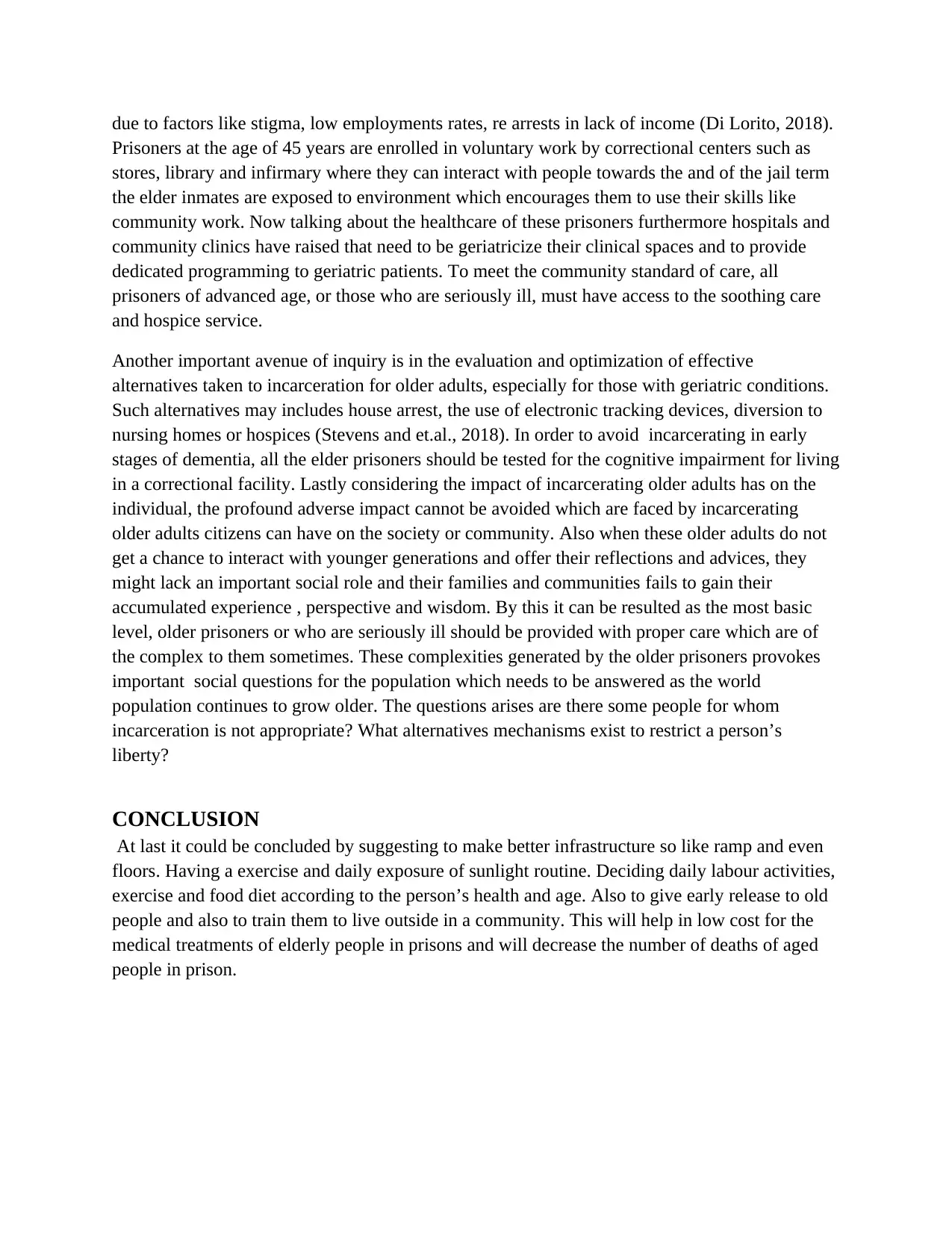
due to factors like stigma, low employments rates, re arrests in lack of income (Di Lorito, 2018).
Prisoners at the age of 45 years are enrolled in voluntary work by correctional centers such as
stores, library and infirmary where they can interact with people towards the and of the jail term
the elder inmates are exposed to environment which encourages them to use their skills like
community work. Now talking about the healthcare of these prisoners furthermore hospitals and
community clinics have raised that need to be geriatricize their clinical spaces and to provide
dedicated programming to geriatric patients. To meet the community standard of care, all
prisoners of advanced age, or those who are seriously ill, must have access to the soothing care
and hospice service.
Another important avenue of inquiry is in the evaluation and optimization of effective
alternatives taken to incarceration for older adults, especially for those with geriatric conditions.
Such alternatives may includes house arrest, the use of electronic tracking devices, diversion to
nursing homes or hospices (Stevens and et.al., 2018). In order to avoid incarcerating in early
stages of dementia, all the elder prisoners should be tested for the cognitive impairment for living
in a correctional facility. Lastly considering the impact of incarcerating older adults has on the
individual, the profound adverse impact cannot be avoided which are faced by incarcerating
older adults citizens can have on the society or community. Also when these older adults do not
get a chance to interact with younger generations and offer their reflections and advices, they
might lack an important social role and their families and communities fails to gain their
accumulated experience , perspective and wisdom. By this it can be resulted as the most basic
level, older prisoners or who are seriously ill should be provided with proper care which are of
the complex to them sometimes. These complexities generated by the older prisoners provokes
important social questions for the population which needs to be answered as the world
population continues to grow older. The questions arises are there some people for whom
incarceration is not appropriate? What alternatives mechanisms exist to restrict a person’s
liberty?
CONCLUSION
At last it could be concluded by suggesting to make better infrastructure so like ramp and even
floors. Having a exercise and daily exposure of sunlight routine. Deciding daily labour activities,
exercise and food diet according to the person’s health and age. Also to give early release to old
people and also to train them to live outside in a community. This will help in low cost for the
medical treatments of elderly people in prisons and will decrease the number of deaths of aged
people in prison.
Prisoners at the age of 45 years are enrolled in voluntary work by correctional centers such as
stores, library and infirmary where they can interact with people towards the and of the jail term
the elder inmates are exposed to environment which encourages them to use their skills like
community work. Now talking about the healthcare of these prisoners furthermore hospitals and
community clinics have raised that need to be geriatricize their clinical spaces and to provide
dedicated programming to geriatric patients. To meet the community standard of care, all
prisoners of advanced age, or those who are seriously ill, must have access to the soothing care
and hospice service.
Another important avenue of inquiry is in the evaluation and optimization of effective
alternatives taken to incarceration for older adults, especially for those with geriatric conditions.
Such alternatives may includes house arrest, the use of electronic tracking devices, diversion to
nursing homes or hospices (Stevens and et.al., 2018). In order to avoid incarcerating in early
stages of dementia, all the elder prisoners should be tested for the cognitive impairment for living
in a correctional facility. Lastly considering the impact of incarcerating older adults has on the
individual, the profound adverse impact cannot be avoided which are faced by incarcerating
older adults citizens can have on the society or community. Also when these older adults do not
get a chance to interact with younger generations and offer their reflections and advices, they
might lack an important social role and their families and communities fails to gain their
accumulated experience , perspective and wisdom. By this it can be resulted as the most basic
level, older prisoners or who are seriously ill should be provided with proper care which are of
the complex to them sometimes. These complexities generated by the older prisoners provokes
important social questions for the population which needs to be answered as the world
population continues to grow older. The questions arises are there some people for whom
incarceration is not appropriate? What alternatives mechanisms exist to restrict a person’s
liberty?
CONCLUSION
At last it could be concluded by suggesting to make better infrastructure so like ramp and even
floors. Having a exercise and daily exposure of sunlight routine. Deciding daily labour activities,
exercise and food diet according to the person’s health and age. Also to give early release to old
people and also to train them to live outside in a community. This will help in low cost for the
medical treatments of elderly people in prisons and will decrease the number of deaths of aged
people in prison.
⊘ This is a preview!⊘
Do you want full access?
Subscribe today to unlock all pages.

Trusted by 1+ million students worldwide
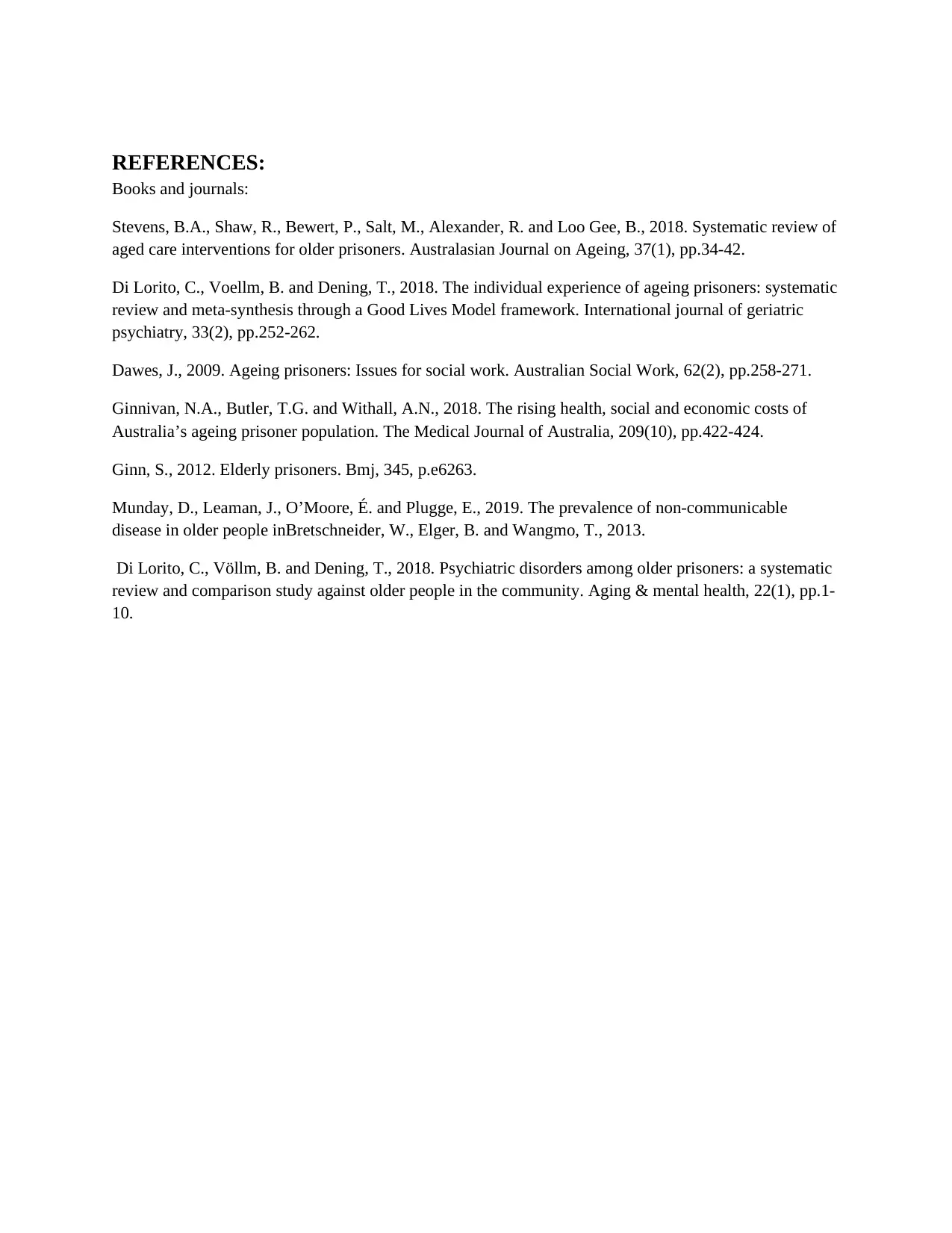
REFERENCES:
Books and journals:
Stevens, B.A., Shaw, R., Bewert, P., Salt, M., Alexander, R. and Loo Gee, B., 2018. Systematic review of
aged care interventions for older prisoners. Australasian Journal on Ageing, 37(1), pp.34-42.
Di Lorito, C., Voellm, B. and Dening, T., 2018. The individual experience of ageing prisoners: systematic
review and meta‐synthesis through a Good Lives Model framework. International journal of geriatric
psychiatry, 33(2), pp.252-262.
Dawes, J., 2009. Ageing prisoners: Issues for social work. Australian Social Work, 62(2), pp.258-271.
Ginnivan, N.A., Butler, T.G. and Withall, A.N., 2018. The rising health, social and economic costs of
Australia’s ageing prisoner population. The Medical Journal of Australia, 209(10), pp.422-424.
Ginn, S., 2012. Elderly prisoners. Bmj, 345, p.e6263.
Munday, D., Leaman, J., O’Moore, É. and Plugge, E., 2019. The prevalence of non-communicable
disease in older people inBretschneider, W., Elger, B. and Wangmo, T., 2013.
Di Lorito, C., Vӧllm, B. and Dening, T., 2018. Psychiatric disorders among older prisoners: a systematic
review and comparison study against older people in the community. Aging & mental health, 22(1), pp.1-
10.
Books and journals:
Stevens, B.A., Shaw, R., Bewert, P., Salt, M., Alexander, R. and Loo Gee, B., 2018. Systematic review of
aged care interventions for older prisoners. Australasian Journal on Ageing, 37(1), pp.34-42.
Di Lorito, C., Voellm, B. and Dening, T., 2018. The individual experience of ageing prisoners: systematic
review and meta‐synthesis through a Good Lives Model framework. International journal of geriatric
psychiatry, 33(2), pp.252-262.
Dawes, J., 2009. Ageing prisoners: Issues for social work. Australian Social Work, 62(2), pp.258-271.
Ginnivan, N.A., Butler, T.G. and Withall, A.N., 2018. The rising health, social and economic costs of
Australia’s ageing prisoner population. The Medical Journal of Australia, 209(10), pp.422-424.
Ginn, S., 2012. Elderly prisoners. Bmj, 345, p.e6263.
Munday, D., Leaman, J., O’Moore, É. and Plugge, E., 2019. The prevalence of non-communicable
disease in older people inBretschneider, W., Elger, B. and Wangmo, T., 2013.
Di Lorito, C., Vӧllm, B. and Dening, T., 2018. Psychiatric disorders among older prisoners: a systematic
review and comparison study against older people in the community. Aging & mental health, 22(1), pp.1-
10.
1 out of 7
Related Documents
Your All-in-One AI-Powered Toolkit for Academic Success.
+13062052269
info@desklib.com
Available 24*7 on WhatsApp / Email
![[object Object]](/_next/static/media/star-bottom.7253800d.svg)
Unlock your academic potential
Copyright © 2020–2025 A2Z Services. All Rights Reserved. Developed and managed by ZUCOL.





